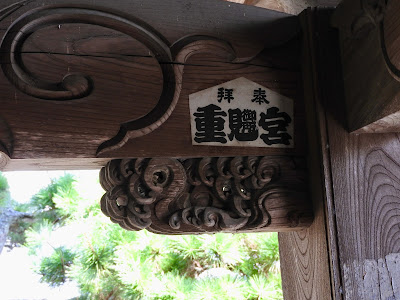 |
| バースディ・ウォーク Birthday Walk |
目次 / Contents
1) 星と虚空蔵菩薩 / Star and Ākāśagarbha
2) 虚空蔵堂へ / To Kokuzo-do Hall
3) 極楽寺坂切通 / Gokuraku Pass
 |
| Gokurakuji and Hase Area Map in Japanese |
1) 星と虚空蔵菩薩 / Star and Ākāśagarbha
 |
| '星の井' / 'Hoshi no I' |
極楽寺坂切通沿いには、鎌倉十井 (カマクラジッセイ) の1つ、星の井 (星月の井) があり、それと隣接して星の井寺こと
虚空蔵堂 (コクウゾウドウ) があります。
星月の井の名前は、井戸の中に、昼間でも星の影が見えたことに由来します。
伝説・詳細についてはこちら→★
伝説によると...。
行基はその菩薩を仏像に彫りお堂を建立しました。
それが星の井寺、正式名、
明鏡山円満院星井寺 (ミョウキョウザン エンマンインホシイデラ) です。
その後、近所の女性が誤って包丁を井戸に落とし、星は見えなくなりました。"
[行基は、
聖武天皇 (ショウムテンノウ / 701 - 756 / 在位 : 724 -749) により
"四聖 (シショウ/ シセイ)" の一人になりました。]
伝説の内容の細部には違いがあり、上記の他に現地での案内板
(下の画像) に紹介されている話もあります。
現在は、成就院が管理をし、虚空蔵堂 (コクウゾウドウ) と呼ばれています。
 |
| 星の井の伝説 Information board about 'Hoshi no I' Legend in Japanese |
Star and Ākāśagarbha
I and my husband R walked along Gokuraku Pass towards Yuigahama after Jojuin Temple.
About Joju-in Temple below.
On Gokuraku Pass, there is one of 'Ten Wells of Kamakura' (Kamakura Jissei), 'Hoshi no I (Hoshitsuki no I)', and adjacent to it is 'Hoshi no I-Temple', Kokuzo-do Hall.
('Hoshi no I' means Well of Stars)
The name, 'Hoshi no I' comes from the fact that the shadow of a star can be seen in the well even in the daytime.
According to one of Legends ...
"When Great Buddhist Priest Gyōki (668 - 749) looked into the well where the stars could be seen even in the daytime, he saw the figure of Ākāśagarbha : Kokuzo Bosatsu.
Gyōki carved the Ākāśagarbha into a Buddhist statue and built
a temple.
This is the 'Hoshi no I-Temple', the official name,
Myoukyozan-Enmanin-Hoshi Temple.
After that, a woman in the neighbourhood accidentally dropped
a knife into a well and the stars disappeared. "
[Gyōki was invited by Emperor Shomu (701 - 756 / reign : 724 - 749) as the person in charge of the Great Buddha of Nara, and later became one of the "Four Sages" of Todaiji Temple.]
There are differences in the details of the legendary content, and in addition to this there is also a story introduced on the local information board, image above.
Currently, it is managed by Jojuin Temple and is called
'Kokuzo-do Hall'.
2) 虚空蔵堂へ / To Kokuzo-do Hall
 |
| 極楽寺坂切通に設置されている大きな案内板 虚空蔵堂が見過ごしてしまう位置にあるので、人々の関心を集めるために 設置されていると思います。 Large information board of Kokuzo-do Hall installed at Gokuraku Pass in Japanese Since the Kokuzo-do Hall is in a position which can be missed, I think it is installed to attract people's attention. |
星の井のすぐ隣に虚空蔵堂 へ登る階段があります。
2月に星月の井を訪れたときには、階段下からご挨拶をしただけでした。
今回は、階段を登り、虚空蔵菩薩 (コクウゾウボサツ) 様へご挨拶をしました。
また、虚空蔵菩薩は無限の知恵を持ち、人々に知恵を授けるともされているそうな....。
"明けの明星" の化身・象徴とされている虚空蔵菩薩が星の井の隣に位置しているのは奇遇と思ったのですが、伝説の中で、すでに星と
虚空蔵菩薩は結びつけられていました。
私にとって"明けの明星"である金星は、美の女神です。
仏様の世界では、知恵、ローマ・ギリシア神話では、愛と美の女神になるのは面白く感じます。
双方の世界とも、金星は武力でなく、文学の領域の象徴なのですね〜。
 |
| 虚空蔵堂への階段 Steps to Kokuzo-do Hall |
To Kokuzo-do Hall
When I visited 'Hoshizuki-no-I' in February, I just greeted from the bottom of the steps.
This time, we climbed the steps and greeted Ākāśagarbha.
"Morning Star" (Venus) is considered to be the incarnation and symbol of the Ākāśagarbha.
In addition, Ākāśagarbha has infinite wisdom and is said to give wisdom to people ....
I thought it is coincidence that Ākāśagarbha who is considered to be the incarnation and symbol of "Morning Star" is located next to 'Hoshizuki-no-I' (Well of Stars), however, in the legend, the star and Ākāśagarbha are already linked.
For me, Venus, as "Morning Star" is the Goddess of Beauty.
In the world of Buddha, Venus relates to wisdom, in Roman and Greek mythologies Venus is to be a Goddess of love and beauty, this is interesting.
In both worlds, Venus is not an armed force, but a symbol of the literary realm.
 |
| 虚空蔵堂 詳細はここで→★ Kokuzo-do Hall Click here for details → ★ |
賽銭泥棒 (サイセンドロウボウ) をする人が本当にいるのだな〜と驚きつつ、よほど困っていたのか、いたづら心でしたのか...と思い巡らします。
ですが、どんな理由であるにしろ仏様は許すであろうと思います。
賽銭が惜しくて堂内に賽銭箱が移動したというよりも、盗人が罪を重ねないようにという思いであろうと私は考えました。
参拝客の思いが含まれた賽銭を菩薩様からくすねる人の罪は重いから、盗人を救うための処置だと思うのです。
 |
| 同じ理由で鐘の後ろも撮影可能です。 右に見える道が極楽寺坂切通につながっています。 For the same reason, I can also photograph behind the bell. The road on the right leads to Gokuraku Pass. |
I was surprised that there really was a person who was a saisen thief, but I wondered if the thief was in great trouble or if the thief had a mischievous heart.
(Saisen means money offering.)
However, I think the Buddha would forgive for whatever reason.
I guess that their idea is to prevent thieves from committing sins rather than keeping the money.
Since the sin of a person who sneaks a donation containing the thoughts of worshipers from a Bodhisattva is heavy, I think it is a measure to save the thief.
 |
| 右の木彫 獅子 (シシ) でしょうか? Right Wooden Carving Is this a Lion?  後ろ/ Back |
千社札 (センジャフダ) が多く貼られていることに少なからぬ驚きを覚えました。
I was quite surprised that many Senjafuda were affixed.
According to Wiki about Senjafuda,
"Senjafuda are votive slips or placards posted on the gates or buildings of shrines and Buddhist temples in Japan. "
 |
左の木彫 / Left Wooden Carving 後ろ/ Back |
 |
| 小さな石碑 これがなんのためかわかりませんが、 目に止まり、心が惹かれました。 Small Stone Monument I don't know what this is for, but it caught my eye and attracted my heart. |
 |
| 最後に空を見上げて、階段をおりました。 Lastly, I looked up at the sky and went down the steps. |
3) 極楽寺坂切通 / Gokuraku Pass
 |
| 極楽寺駅前の案内板 Information board in front of Gokurakuji Station About Gokuraku Pass →★ |
 |
| 日限地蔵菩薩 極楽寺坂切通にある日限地蔵 (ヒギリジゾウ) です。 私は日限地蔵 を初めて知りました。 '日を限って祈願すると願いが叶えられる' といわれる地蔵菩薩です。 日限地蔵 はここだけでなく、日本全国にあります。 Higiri-Jizo Kṣitigarbha This is 'Higiri-Jizo Kṣitigarbha' on Gokuraku Pass. This is the first time I knew this Jizo is 'Higiri-Jizo Kṣitigarbha'. It is a Kṣitigarbha who is said to be able to fulfill people's wishes by praying for a limited number of days. |
The next section is about a 'Cafe ・Fukubiyori'.









0 件のコメント:
コメントを投稿